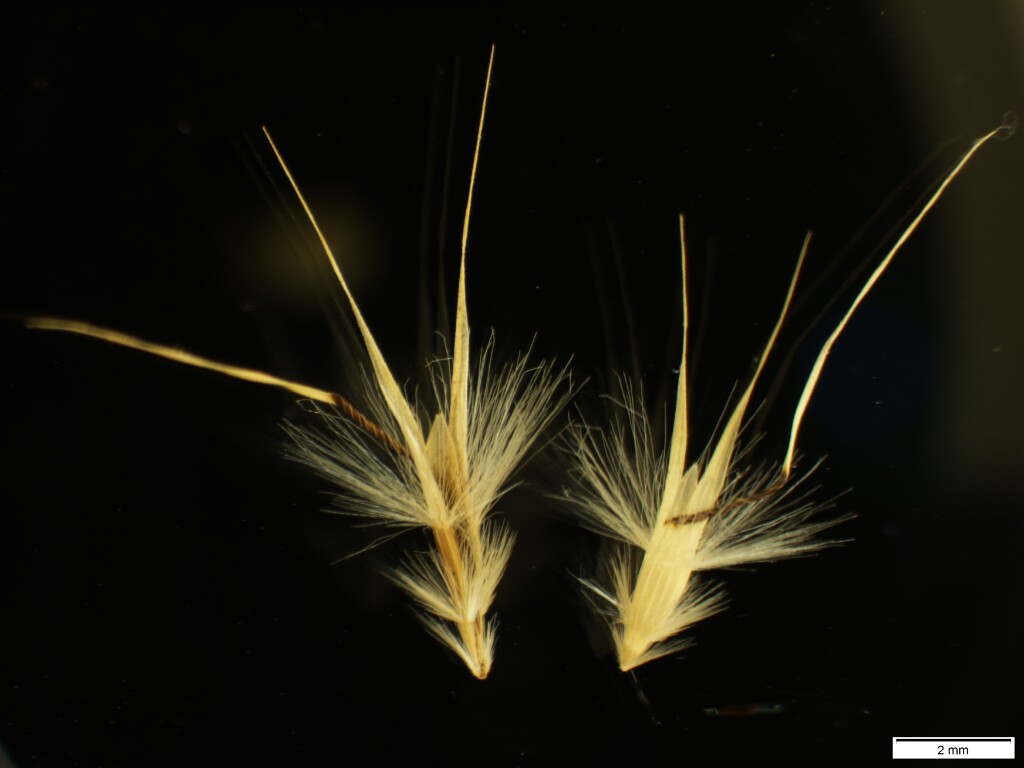Rytidosperma caespitosum
(Gaudich.) Connor & Edgar Common Wallaby-grassVariable tufted perennial. Culms to 90 cm high. Leaves glabrous to (more commonly) hairy; blade flat to inrolled, to 30 cm long and mostly 1–3 mm wide. Panicle lanceolate, mostly dense, occasionally open and conspicuously branched or reduced to a few spikelets, mostly 3–8 cm long. Spikelets usually purplish when young, mostly 6–9-flowered; glumes subequal, acute, 14–24 mm long; lemma narrow, usually 3.5–5.5 mm long, with 2 rows of hairs, the lower 1–1.5 mm above the callus hair-tuft; lateral lobes erect, c. 7–15 mm long, acuminate, the flat part typically rather broad and abruptly tapering to the setae which are generally longer than the flat part; central awn exceeding lateral lobes by 4–10 mm; palea narrow-lanceolate, membranous and shallowly notched at apex, exceeding the sinus by 1.5–2.5 mm. Flowers mainly Sep.–Dec.
LoM, MuM, Wim, GleP, Brid, VVP, VRiv, MSB, RobP, MuF, GipP, OtP, WaP, Gold, CVU, GGr, DunT, NIS, EGL, EGU, WPro, HSF, HNF, OtR, Strz, MonT, VAlp. Also WA, SA, NSW, ACT, Tas. Occurring across a wide geographical and environmental range, but not abundant in the alps, tall-forest areas or saline environments.
A form from swamps in the far south-west (lower Glenelg River and Dergholm areas) is distinctive in having strongly purplish glumes, lemmas with short lateral lobes barely exceeding the stout, twisted part of the central awn and frequently, the lemma body with scattered hairs between the rows.
A coastal variant (known from Anglesea, Frankston area, Phillip Is. and south Gippsland east to Golden Beach) is distinguished in having smooth, glabrous and variably glaucous foliage, often with reddish sheaths, and lemmas with a relatively long upper series of hairs and lateral lobes which taper evenly from the base to the setiform part. This variant also occurs in South Australia and Tasmania.
Apart from these apparently distinct forms, the degree of adaptability to different environmental conditions is equalled by the variability shown in most features of this species and specimens which appear to be intermediate between Rytidosperma caespitosum and other species are not uncommon. These apparent intermediates most commonly approach R. setaceum, R. erianthum, R. tenuius, R. indutum and R. racemosum respectively in approximate order of frequency on herbarium specimens. A critical assessment of the R. caespitosum complex is required to evaluate the taxonomic status of the forms outlined above (and undoubtedly other forms as yet undetected).
Recently, R. robertsoniae Tiver has been segragated from R. caespitosum, see profile for the former species for comparison between the two species.
Walsh, N.G. (1994). Poaceae. In: Walsh, N.G.; Entwisle, T.J., Flora of Victoria Vol. 2, Ferns and Allied Plants, Conifers and Monocotyledons, pp. 356–627. Inkata Press, Melbourne.
 Spinning
SpinningTiver, F. (2020). Rytidosperma robertsoniae (Poaceae), a new species from southern Australia . Swainsona 33: 31–42.




